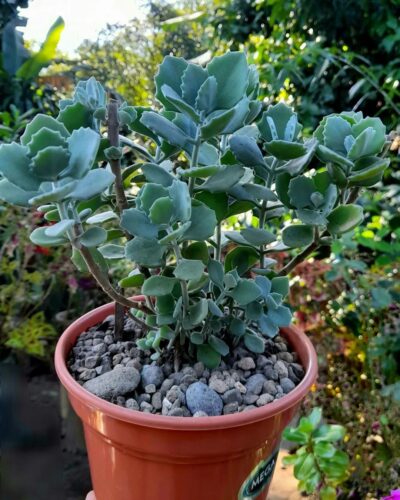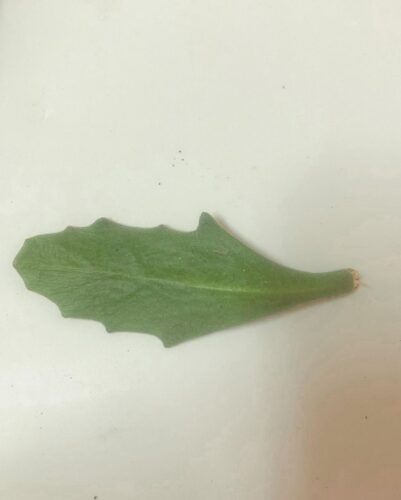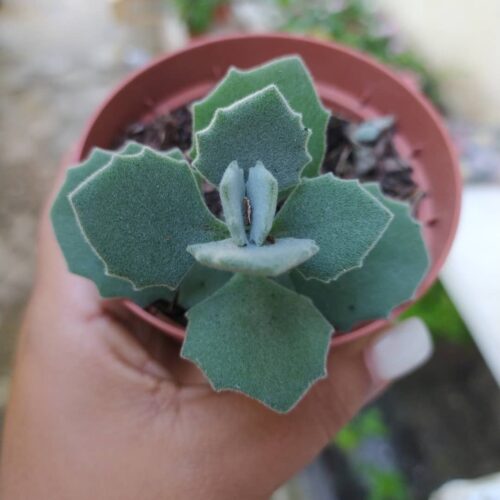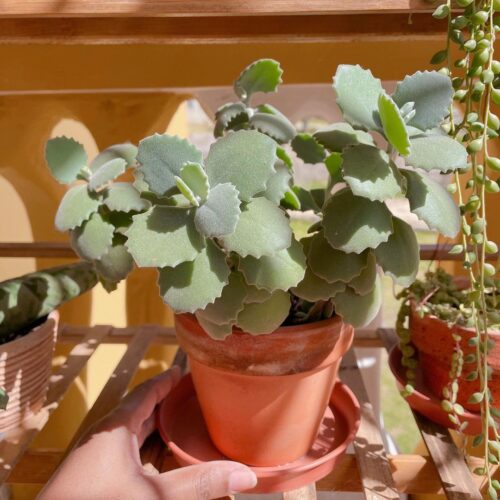Explore this Kalanchoe Millotii Care and Growing Guide to include this beautiful succulent in your plant collection.
Discover this Kalanchoe Millotii Care and Growing Guide! If you’re a succulent enthusiast or a beginner looking to care for this unique and fuzzy-leaved plant, you’re in the right place. In this guide, read easy-to-follow tips and grow a healthy and thriving Kalanchoe Millotii.
READ Sedum Nussbaumerianum Care Guide
Kalanchoe Millotii Profile

Millot Kalanchoe, or Kalanchoe millotii, is a succulent plant from the Crassulaceae family. It is native to Madagascar, which means this succulent naturally grows there. This plant has hazy or bluish-green leaves covered in fine, silvery-white hairs, giving them a slightly fuzzy texture.
Kalanchoe millotii is considered a relatively slow grower. It typically reaches a height of about 6 to 12 inches (15 to 30 centimeters) and can spread to a similar width over time.
The flowers of Kalanchoe millotii are small, tubular, and usually green-yellow in color. These flowers form in clusters on tall stems that rise above the foliage. Flowering typically occurs in the spring and early summer.
CHECK Graptopetalum Paraguayense Growing and Care Guide
How to Propagate Kalanchoe millotii

Methods for propagating Kalanchoe millotii:
- Leaf Cuttings
- Offsets
- Stem Cuttings
- Select a healthy leaf from the parent plant. Choose a leaf that is mature but not too old or too young. The ideal leaf is typically plump and free from any signs of disease or damage.
- Use a clean, sharp knife or scissors to remove the selected leaf from the parent plant carefully.
- Make a clean cut, ensuring a whole leaf with no tears or jagged edges.
- Allow the cut end of the leaf to dry and callus over. This usually takes a day or two. Placing the cut end in a dry, shaded area will help.
- Once the cut end is callused, prepare a small pot or container with well-draining succulent or cactus potting mix. Make a shallow hole in the soil using a pencil or your finger.
- Plant the callused end of the leaf in the hole in the potting mix, burying it about 1/2 inch (1.25 centimeters) deep. Gently pat the soil around the leaf to secure it.
- Water the newly planted leaf lightly, ensuring without soaking the soil. It’s essential to keep the soil consistently moist but not waterlogged during the propagation process.
- Place the pot in a location with bright, indirect light. Avoid direct sunlight, as it can scorch the fragile leaf.
- Over the next few weeks, new roots and tiny plantlets will start to form at the base of the leaf. Be patient, as this process can take some time.
- Once the plantlets have grown large enough to handle, you can carefully transplant them into individual pots or containers with the same type of soil mix used for the parent plant.
Pot Size for Growing Kalanchoe millotii
For Kalanchoe millotii, the ideal pot size is 4 to 6 inches (10 to 15 cm) in diameter. Choose a pot made of clay or terracotta for breathability and stability. Ensure the pot has drainage holes to prevent waterlogging, promoting well-draining succulent or cactus potting mix to maintain optimal moisture levels.
Explore Elephant Bush vs. Jade Plant: Differences
Ideal Growing Conditions for Kalanchoe millotii

Light / Location
Kalanchoe millotii requires bright, indirect sunlight to thrive. Place it near a sunny window with filtered light or in a spot with partial shade if grown outdoors. Avoid direct, harsh sunlight, as it can harm the plant’s delicate leaves, causing them to become scorched or damaged.
Soil
Kalanchoe millotii thrives in well-draining soil. A mix of cactus or succulent potting soil with perlite or sand for added drainage works well. It should be slightly acidic to neutral in pH. Ensure the soil dries out between watering to prevent root rot and maintain optimal growth conditions.
Water
Kalanchoe millotii prefers moderate watering. Allow the soil to dry partially between watering, typically every 2-3 weeks. Water sparingly during the dormant winter months. Avoid overwatering, as it can lead to root rot. Always water at the base of the plant to prevent moisture on the leaves, which can cause damage.
Temperature and Humidity
This succulent favors average room temperatures between 60-75°F (15-24°C). It’s adaptable to slightly cooler conditions but should be protected from frost. Humidity levels are not critical; Kalanchoe millotii does well in typical indoor humidity. Ensure good air circulation to prevent excess moisture around the plant, which can lead to fungal issues.
FIND: Is Agave a Cactus or Not?
Kalanchoe millotii Care

Fertilizer
Kalanchoe millotii benefits from a balanced, diluted liquid fertilizer during its active growing season in spring and summer. Use a general-purpose, water-soluble fertilizer with a balanced NPK ratio (such as 20-20-20) and apply it every 4-6 weeks. Avoid fertilizing during the dormant winter months. Always follow the manufacturer’s instructions for proper dilution and application to prevent over-fertilization, which can harm the plant.
Repotting
Repot Kalanchoe millotii when it becomes root-bound, outgrows its current container, or shows signs of instability, such as tipping over easily. This typically occurs every 2-3 years during the spring. Choose a slightly larger pot with well-draining soil and transplant during the active growing season for the best support and growth.
Pruning
Prune Kalanchoe millotii sparingly as needed to remove dead or damaged leaves, encourage bushier growth, or maintain its desired shape. Use clean, sharp scissors or pruning shears and trim just above a leaf node. Avoid excessive pruning to prevent stress on the plant.
Read about Dischidia Nummularia Care
Pests and Diseases
Kalanchoe millotii is generally a hardy plant, but it can still face some common pests and diseases:
Pests:
- Mealybugs: These small, white, cottony insects can infest the plant, especially in crevices or along leaf stems. Treat with neem oil or insecticidal soap.
- Aphids: Aphids are tiny, soft-bodied insects that may cluster on the undersides of leaves. Rinse them off with a strong stream of water or use insecticidal soap.
- Spider Mites: These tiny arachnids can create fine webbing on the plant and cause yellowing leaves. Use a strong spray of water or neem oil to control them.
Diseases:
- Root Rot: Overwatering or poorly draining soil can lead to root rot. Ensure the soil dries out between waterings to prevent this fungal disease.
- Leaf Spot: Leaf spot diseases can cause dark spots or lesions on the leaves. Remove affected leaves and improve air circulation to prevent further spread.
- Powdery Mildew: A white, powdery fungal growth on leaves can be treated with a fungicide. Ensure good air circulation and avoid overcrowding plants.
Proper care, including maintaining appropriate watering practices and providing good ventilation, can help prevent these issues in Kalanchoe millotii. Regular inspection of your plant can catch problems early and prevent them from spreading.
Check out Best Companion Plants for Pest Control
FAQs

1. Can I grow Kalanchoe millotii outdoors?
Yes, you can grow it outdoors in a location with filtered or partial sunlight, but protect it from direct, intense sun and frost. Ensure well-draining soil in outdoor plantings.
2. Can I grow Kalanchoe millotii in a hanging basket?
While it’s typically grown in pots or containers, you can grow it in a hanging basket as long as it receives the right amount of light and proper care. Ensure the basket has drainage holes.
3. How can I encourage Kalanchoe millotii to bloom?
Kalanchoe millotii produces small, tubular greenish-yellow flowers in late winter to spring. To encourage blooming, provide cooler temperatures (around 50-60°F or 10-15°C) for a few weeks in late fall.
4. Is Kalanchoe millotii toxic to pets or humans?
Kalanchoe millotii can be mildly toxic if ingested. Keep it out of reach of pets and children, and be cautious if you have curious pets that may nibble on plants.
5. What are the signs that my Kalanchoe millotii needs more or less light?
If it’s receiving too little light, it may become leggy, with elongated stems and reduced leaf coloration. If it’s getting too much light, the leaves may develop sunburn spots or become discolored.



